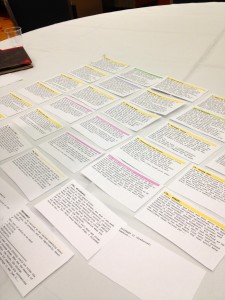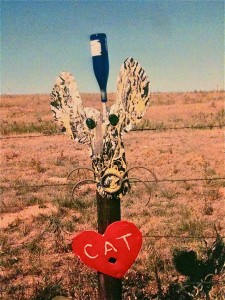
For example. The last few days I’ve been working at getting back into the flow of writing daily. I held myself accountable and post daily word counts here or on Twitter. And lemme tell you, some of those words were difficult to wrestle out of my skull and onto the page. One way I can tell things are going in difficult fits and spurts is that I’ll hop around a lot from story to story.
One of those projects is “Prairiedog Town” (which is definitely getting a different title). I started jotting down mental notes for it while traveling through Kansas, but only had a thousand words or so on it before last week. It was slow writing, partially because I wasn’t sure how I was getting from one point to another in the story. I knew it was a piece about a woman reclaiming her humanity and I had a good idea of what the penultimate scene would look like.
So I kept jotting words down in sporadic clumps of a few hundred at a time, yerking the story along in an awkward and impatient way. It helped when I incorporated a prompt from Sandra M. Odell, a woman finding an abandoned teddy bear by the road. But it still was slow slogging. Yesterday I took a break from it.
And then, this morning, while working on it, things began to fall into place. A secondary character had popped up, and I understood how to bring her back into the story — and why. A piece that was supposed to take three days suddenly shortened into a single night, and with that, the ultimate scene came clear. I went through, pulling the threads into place as close to a thousand words came spilling out and into the story.
It’s not done yet — maybe another thousand words to go, but I’ve got a map of it, and comments where I need to go back and insert things. Here, for example, is what a section of today’s work looks like:
They end up chatting. Talia asks after father. Relates that he’s died. Talia asks if she’s going to the funeral.
No
It’s what you’d say either way, isn’t it.
That’s true
I’ll be there. On the outskirts.She freezes again. It’s an old code word they used to use, back in the days when they worked together. It’s someplace close but (some distance) to the (direction).
And most importantly at all, things have come together to a point where I’m excited about the story, feel that some clever stuff has been worked in or has had places made for it. It’ll end up being around 4-5 thousand words, and I know I’ll finish it by the end of this month, because it’s designated as the next story to go out in the Patreon campaign.
And if I hadn’t done that picking away at it — scraping those words out of my skull, even though it felt painful and awkward and uninspired — I would have never gotten to that point at all.
Enjoy this writing advice and want more content like it? Check out the classes Cat gives via the Rambo Academy for Wayward Writers, which offers both on-demand and live online writing classes for fantasy and science fiction writers from Cat and other authors, including Ann Leckie, Seanan McGuire, Fran Wilde and other talents! All classes include three free slots.
Prefer to opt for weekly interaction, advice, opportunities to ask questions, and access to the Chez Rambo Discord community and critique group? Check out Cat’s Patreon. Or sample her writing here.










4 Responses
I just wanted to say– first, thank you for the reminder that it’s useful to continue dragging yourself forward even when you’re not feeling it. And second, I’d completely missed that you were posting daily wordcounts, and now that I’ve seen them I feel a lot better–that they’re there, that they’re measurable, that kicking around more than one story at a time is reasonable, that even a few words at a time count–so thank you for sharing.
I figure one of the best ways to teach is by example. 🙂 Glad it’s useful!
Cat, this is the best example of how an author writes a short story that I’ve seen. People ask me how I write mine, and words fail me. When I try to explain, they just stare at me. LOL. I’ve decided that stories aren’t written so much as they are built, one element at a time. And even then, not always from the ground up.
Thanks Bobbi! There’s so many different ways to write a story — and the vast majority of them are not in a linear order. 🙂